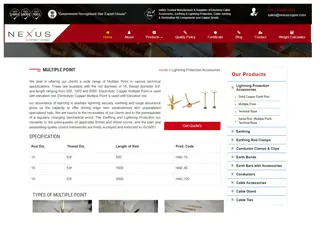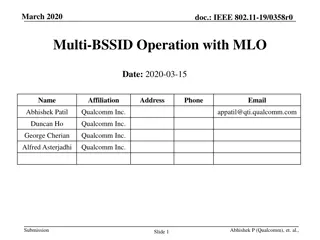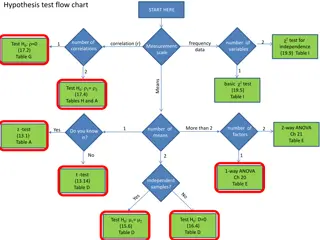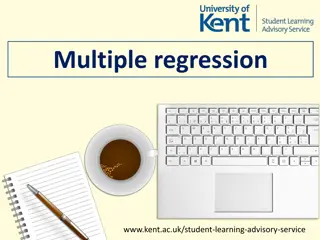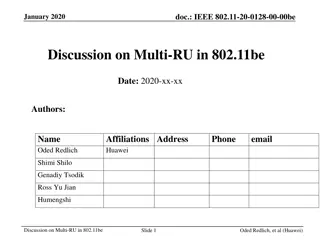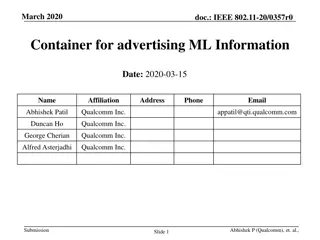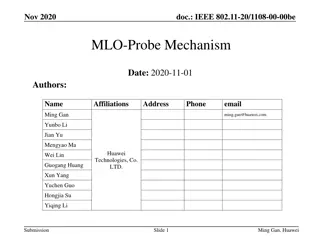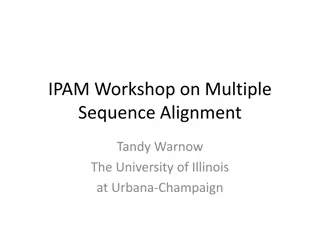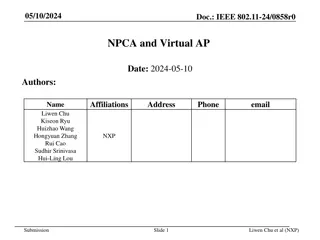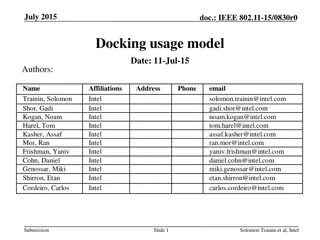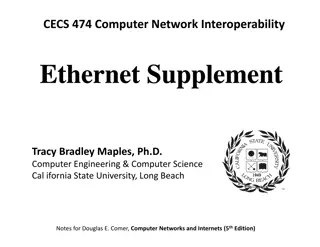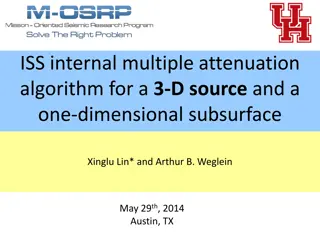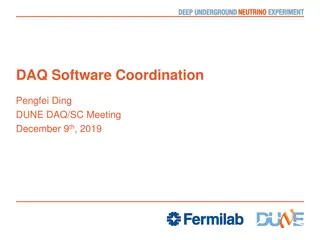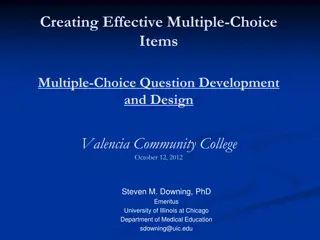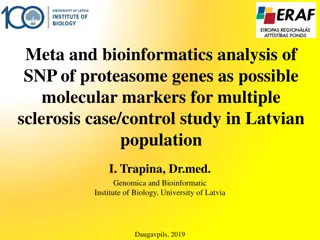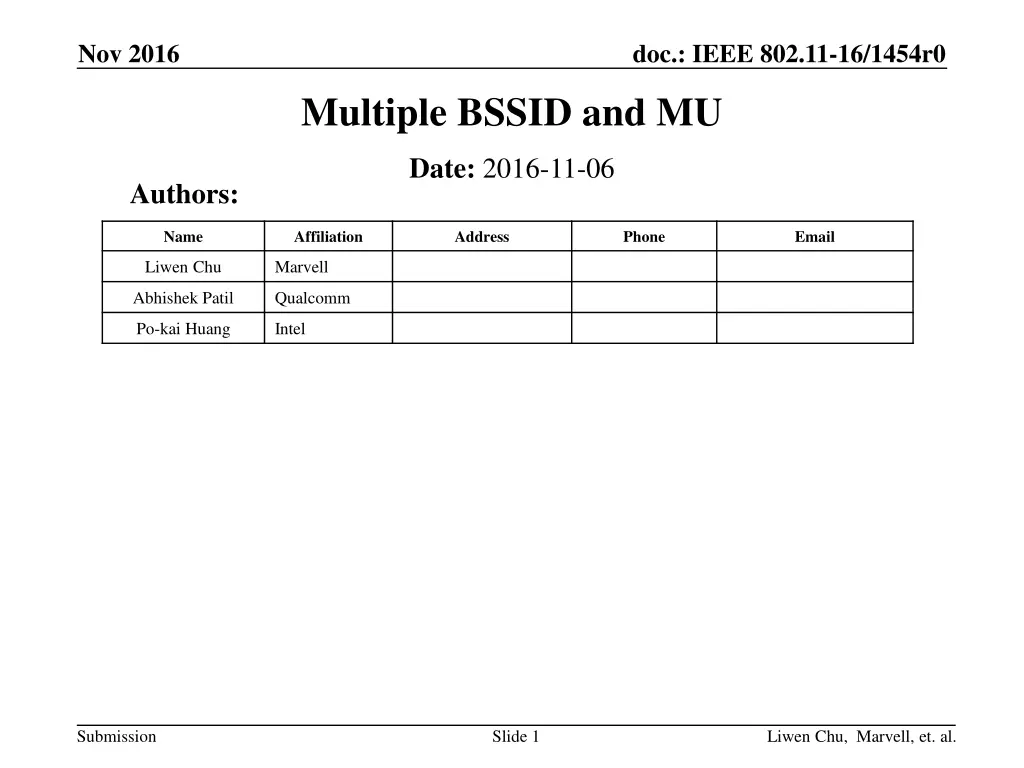
IEEE 802.11-16/1454r0: Multiple BSSID and MU in 802.11ax
Explore the implications of multiple BSSID and MU in 802.11ax, including challenges with TA definition, frame transmission, and control frame support for HE devices operating in multi-BSSID mode. Learn about designations, frame elements, and key considerations for AP devices supporting virtual APs.
Download Presentation

Please find below an Image/Link to download the presentation.
The content on the website is provided AS IS for your information and personal use only. It may not be sold, licensed, or shared on other websites without obtaining consent from the author. If you encounter any issues during the download, it is possible that the publisher has removed the file from their server.
You are allowed to download the files provided on this website for personal or commercial use, subject to the condition that they are used lawfully. All files are the property of their respective owners.
The content on the website is provided AS IS for your information and personal use only. It may not be sold, licensed, or shared on other websites without obtaining consent from the author.
E N D
Presentation Transcript
Nov 2016 doc.: IEEE 802.11-16/1454r0 Multiple BSSID and MU Date: 2016-11-06 Authors: Name Affiliation Address Phone Email Liwen Chu Marvell Abhishek Patil Qualcomm Po-kai Huang Intel Submission Slide 1 Liwen Chu, Marvell, et. al.
Nov 2016 doc.: IEEE 802.11-16/1454r0 Recap of Multiple BSSID in 802.11ax In order to support legacy STA, multiple virtual APs belonging to a multi-BSS AP may need to broadcast beacons. AID of virtual AP per TIM element in Beacon are not fixed.. Multicast AID bit position in a TIM element for a virtual AP is not fixed (i.e., depends on which one of the VAP is transmitting a beacon carrying the Multiple BSSID element) In one DL MU and UL MU transmission, frames from multiple BSSs or to multiple BSSs can be transmitted. It is not clear how to define TA of group-addressed frames in broadcast RU. It is not clear how to define the TA of a Trigger frame that destined to STAs associated with single virtual AP or the TA of a Trigger frame that destined to STAs associated with multiple virtual APs. The RA of frames in UL MU PPDU is not clearly defined. Submission Slide 2 Liwen Chu, Marvell, et. al.
Nov 2016 doc.: IEEE 802.11-16/1454r0 Transmitted BSSID in 11ax An HE AP device that operates in multi-BSSID mode shall designate one BSSID as the one that that takes the primary role to transmit Multiple BSSID element in Beacon and Probe Response frames Frames carry Multiple BSSID element which contains information about all the nontransmitted BSSs that the AP device supports. As per 802.11 baseline, an HE AP device that supports multiple BSS includes two types of virtual APs: AP with transmitted BSSID: the single virtual AP with transmitted BSSID will broadcast Beacon with Multiple BSSID element. AP with nontransmitted BSSID: other virtual APs shall not broadcast Beacon with Multiple BSSID element, however they may broadcast Beacons without Multiple BSSID element when the virtual APs assume that legacy STAs will associate with them. For each nontransmitted BSSID there is a unique transmitted BSSID. Therefore, the relative index for deriving the nontransmitted BSSID and group-addressed AID is always fixed. MaxBSSID Indicator field and Tx BSSID Indicator field are added to HE Operation element. With MaxBSSID Indicator value n, a HE STA associated with a virtual AP which owns nontransmitted BSSID figure out transmitted BSSID 48-n MSB. The Tx BSSID Indicator indicates whether an HE AP corresponds to transmitted BSSID. Submission Slide 3 Liwen Chu, Marvell, et. al.
Nov 2016 doc.: IEEE 802.11-16/1454r0 Multi-BSSID Control Frame Support 802.11 Baseline spec states that for the STA that supports Multi-BSSID functionality, the STA shall support frame filtering for up to two BSSIDs (one for the transmitted BSSID and one for the nontransmitted BSSID) for Beacon, Probe Response, and TIM broadcast frames. To extend Multi-BSSID functionality to control frames, we expect that the STA then needs to support frame filtering for up to two BSSIDs (one for the transmitted BSSID and one for the nontransmitted BSSID) for control frame as well. This adds more requirement to 11ax implementation. Due to this reason, we propose that It is optional for non-AP STA associated with a BSS corresponding to a nontransmitted BSSID to support reception of control frame with TA equal to transmitted BSSID Designate a bit in HE Capabilities element to indicate support for multi-BSSID extension of control frames An HE AP shall only address a STA associated with a BSS corresponding to a nontransmitted BSSID with a control frame with TA equal to transmitted BSSID if the STAs indicate support for multi-BSSID extension of control frames Submission Slide 4 Liwen Chu, Marvell, et. al.
Nov 2016 doc.: IEEE 802.11-16/1454r0 HE STA s Behavior An HE STAs upon receiving such an element may scan the medium to identify the transmitting BSSID and identify the index and multicast AID mapping for its nontransmitted BSSID with respect to the transmitting BSSID This can be done via the Multiple BSSID element carried in the transmitting BSSID s Beacon/Probe Response frames. Upon identifying the transmitting BSSID, an HE STA that announces the support for multi- BSSID extension of control frames shall not discard control frames (specifically Trigger, Multi-STA BA, NDPA) transmitted by the transmitting BSSID. In addition, an HE STA may attempt to associate with the transmitted BSSID if it finds it to be suitable. Submission Slide 5 Liwen Chu, Marvell, et. al.
Nov 2016 doc.: IEEE 802.11-16/1454r0 MU Transmission with Multiple BSSID For group-addressed frames , e.g. Basic Trigger frame, destined to STAs associated with multiple virtual APs, Transmitted BSSID is used as TA of such frames. STAID field value of 2047 identifies RU allocated to all BSSID in MBSS. For group-addressed frames , e.g. Basic Trigger frame, destined to STAs associated with single virtual AP, Virtual AP s BSSID is used as TA of such frames. STAID field value of the virtual AP identifies RU allocated to the virtual AP s BSSID. For both case, the following rules apply: RA fields of all frames in an A-MPDU are same, and TA fields of all frames in an A-MPDU are same. If a frame solicited by Trigger frame is control frame, the RA selection of the control frame uses the TA of the soliciting frame or associated AP s MAC address. If a frame solicited by Trigger frame is data/management frame, the RA of the solicited frame is set to the intended recipient. Submission Slide 6 Liwen Chu, Marvell, et. al.
Nov 2016 doc.: IEEE 802.11-16/1454r0 Summary We propose an HE AP device that operates in multi-BSSID mode shall assign one BSSID as the one that that takes the primary role to transmit Multiple BSSID element in Beacon and Probe Response frames. it is optional for non-AP STA associated with a BSS corresponding to a nontransmitted BSSID to support reception of control frame with TA equal to transmitted BSSID. TA and RA rules with multiple BSSID element. Submission Slide 7 Liwen Chu, Marvell, et. al.
Nov 2016 doc.: IEEE 802.11-16/1454r0 Backup Slides Submission Slide 8 Liwen Chu, Marvell, et. al.
Nov 2016 doc.: IEEE 802.11-16/1454r0 AID of Broadcast RU in DL MU When multiple virtual APs transmit Beacons, broadcast RU for STAs associated with single virtual AP in DL MU is difficult to identify. The reason is that each virtual AP doesn t have a fixed AID for broadcast transmission in a DL broadcast RU. The AID calculation of each virtual AP has different reference BSSID. STAs may miss some Beacon, STAs may have inaccurate TSF time. An AP may change its beacon interval. DL-MU (MU-MIMO or OFDMA) RU control info TA Info 6.4 or 12.8us + GI per symbol 4us BPSK BPSK BPSK BPSK HE- SIGA1 HE- SIGA1 HE- SIGA1 HE- SIGA1 HE- SIGA2 HE- SIGA2 HE- SIGA2 HE- SIGA2 HE-Data-U1 HE-Data-U2 L-STF L-LTF L-SIG RL-SIG L-STF L-LTF L-SIG RL-SIG HE-Data-U3 HE-SIGB(s) HE-STF HE-LTF(s) L-STF L-LTF L-SIG RL-SIG HE-Data-U4 L-STF L-LTF L-SIG RL-SIG Beacon from Virtual AP0 Beacon from Virtual AP1 Beacon from Virtual AP2 DL MU AP0 has AID 2n-1, AP1 has AID0 etc. AP0 has AID 2n-2, AP2 has AID0 etc. AP0 has AID 0, AP1 has AID1 etc. Submission Slide 9 Liwen Chu, Marvell, et. al.
Nov 2016 doc.: IEEE 802.11-16/1454r0 SpecTextsRelatedtoBeacon, ProbeResponse, TIMBroadcast A non-AP STA in which dot11MultiBSSIDActivated is true shall support frame filtering for up to two BSSIDs; one for the transmitted BSSID and one for the nontransmitted BSSID. The STA, when associated with a BSS corresponding to a nontransmitted BSSID, shall discard all Data and Management frames that use the transmitted BSSID as the transmit address, except for Beacon, Probe Response, and TIM broadcast frames. (See 11.1.3.7 Beacon reception) Submission Slide 10 Liwen Chu, Marvell, et. al.

